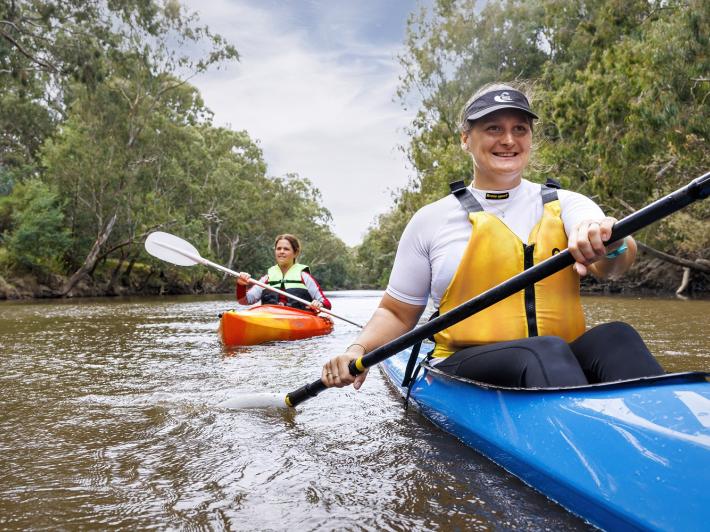
Explainer: How safe is the Yarra River for swimming?
The risk to athletes on the River Seine in Paris during the Olympic Games highlighted some of the issues associated with using urban waterways for recreation.
The Yarra River in Melbourne faces many of the same issues as the Seine, such as pollution from rubbish, grease, oil, and other contaminants that enter our stormwater drainage system.
However, unlike Paris, Melbourne’s wastewater and stormwater are separated. In Melbourne, wastewater (e.g. water from our toilets, showers, and kitchen sinks) is sent to treatment plants, and ‘stormwater’ from gutters, rooftops and streets flows into rivers and creeks
How is the Yarra River assessed for ‘swimmability’?
Various measures are used to determine if water is safe for swimming.
The bacteria E.coli is the best indicator for measuring pollution from faecal contamination in our waterways. Faecal contamination in rivers and creeks comes from animals, including domestic pets, native species and farm animals.
As part of the Yarra Watch program, Melbourne Water and the Environment Protection Authority (EPA) Victoria monitors E.coli levels from four locations along the Yarra: Launching Place, Healesville, Warrandyte, and Kew.
From these four locations, we create a daily forecast of water quality throughout the river, with each site likely to predict the quality of the water upstream. For example, at Kew, the monitoring site tells us what conditions are like in the CBD.
Is it safe to swim in the Yarra? How much E.coli is in the Yarra?
Water quality aside, it’s important to know that there are large stretches of the Yarra where bylaws prevent people from swimming, primarily because the areas may be designated boating or fishing precincts. The CBD section of the Yarra is one of those places.
Some parts of the Yarra River are ‘swimmable’ during dry weather, but people should always check the EPA’s water quality rating forecast on EPA’s Yarra Watch | Environment Protection Authority Victoria (epa.vic.gov.au)
At Warrandyte, water quality regularly met the standard for swimming last year during dry weather. However, the other three sites did not (Launching Place, Healesville, and Kew).
Water quality can vary dramatically day-to-day due to rainfall, pollution incidents and other seasonal factors. For example, in testing this year, E.coli has been recorded at 74 to 6,500 organisms per 100mL along the Kew stretch of the Yarra River; a reading of less than 260 organisms per 100mL is considered safe for swimming.
It’s worth remembering that E.coli readings don’t give us the whole picture, as water quality can vary dramatically due to heavy rainfall or pollution incidents that cause high inflows of urban stormwater or agricultural runoff.
So, the short answer to whether it’s safe to swim in the Yarra is yes, but only in parts.

While three out of four of the monitored sites along the Yarra River did not meet the standard for swimming throughout 2023/24, all four monitoring sites in the Yarra River are considered safe for boating, canoeing, wading, paddling, and fishing.
There are endless possibilities for exploring and enjoying the Yarra River in ways other than swimming.
How is Melbourne Water improving water quality in the Yarra?
We need to use all the tools in the toolbox to improve water quality, including intensive revegetation, better stormwater management, reducing pollutants in waterways, responding swiftly to pollution incidents to pump chemicals away from waterways, and actively increasing the biodiversity of plants and animals, which keep our water healthy.
The Melbourne Water Health Waterways Strategy is the blueprint for guiding our work.
To reduce the flow of contaminants like E.coli into the Yarra, Melbourne Water works with community and agency partners to plant vegetation buffers along the waterway.
In 2022-23, Melbourne Water rehabilitated 155 hectares of streamside vegetation in the Yarra catchment as part of its Healthy Waterways Strategy, bringing the total to over 523 hectares planted over the last five years.
The recent spotlight on the Paris Olympics shows that poor water quality in rivers and lakes is a complex issue worldwide and requires collaborative action from a range of agencies.
Here are some ways people can help keep our rivers and creeks healthy:
- Join a Waterwatch group to monitor the health of waterways.
- Participate in a local creek or river planting day or litter clean-up day.
- Reduce use of fertilisers, insecticides and herbicides that wash down stormwater drains and into waterways.
- Avoid planting invasive plant species (e.g. bamboo, agapanthus) that produce seeds that choke our waterways and reduce water flow.
- Secure your wheelie bin so that rubbish doesn’t end up in the stormwater drain.
- Take your litter home with you (or bin it) when you’re out enjoying nature.
Check if the Yarra is safe to swim: Yarra Watch | Environment Protection Authority Victoria (epa.vic.gov.au)
Background
To see how E.coli data is assessed against the objectives set out in the Victorian Environment Reference Standard (ERS) (2021): The Environment Reference Standard | Environment Protection Authority Victoria (epa.vic.gov.au)
The E.coli data at the four Yarra Watch sites is publicly available via the YarraWatch website: Yarra Watch | Environment Protection Authority Victoria (epa.vic.gov.au)
Burndap Birrarung burndap umarkoo, Yarra Strategic Plan
Media contact:
Call us: 03 9679 7004
Email: [email protected]